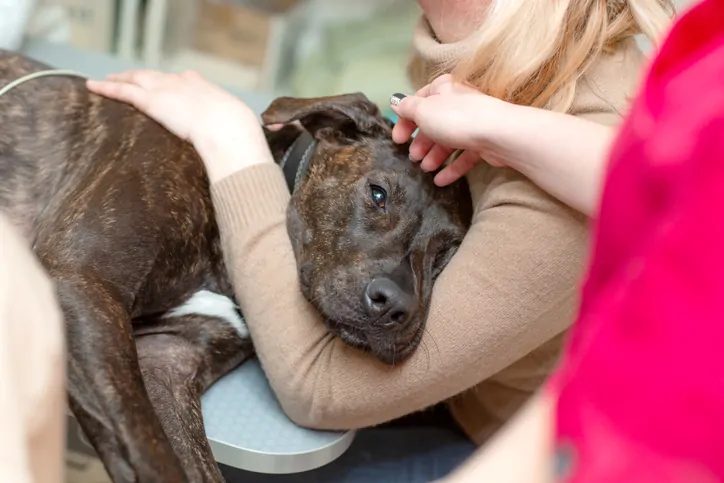Dogs that exhibit changes in energy levels and sleep patterns, gastrointestinal issues, mobility problems, gum changes, fever, itching and gnawing, and behavior changes may be sick.
Some symptoms resolve on their own in a couple of days, monitor your dog's condition for signs of acute distress such as extreme lethargy, fever, and difficulty breathing that require emergency veterinary intervention.
Give your dog all prescribed medications on time, take care of wounds and dressings, feed them vet-recommended food, and provide a comfortable space for them to rest and recover.
Dogs can't express to their owners that they are sick but they wouldn't even if they could. Wild animals are hard-wired to hide pain, injury, and illness to protect themselves from predators when they are in a weakened state. Although they have been domesticated for thousands of years, dogs still have this behavioral trait. It makes it difficult to determine if your dog is in pain, especially since canines are so loyal and loving that they have been known to jump up and greet their humans, even with fractured bones and other injuries.

Dogs are creatures of habit that often develop observable routines which can give clues related to their well-being. Take notice of when your dog is active or at rest and be watchful for changes in those patterns. If your dog appears lethargic, it could say a viral, parasitic, or bacterial infection as well as anemia, injury, poisoning, or reaction to the medication. If your dog appears to have trouble getting a comfortable sleep, seems restless during normal sleep times, or gets up more often in the night, it could be a sign of pain and discomfort. Also, sleeping more than usual could mean your dog has a serious medical issue such as hypothyroidism, kidney disease, diabetes, arthritis, or heart issues.
One of the most obvious and disagreeable signs of sickness in your dog is the development of a gastrointestinal issue. Gastrointestinal disturbances come in a variety of forms including:
Dogs with joint issues, hip dysplasia, arthritis, fractured bone, infections, or other ailments may have trouble walking, rising, and jumping. If your dog is not taking stairs or jumping onto the bed or couch, as usual, this could be a sign that they are experiencing joint pain or have an existing injury. Dogs that show reluctance or stiffness when getting up may be exhibiting early signs of osteoarthritis. Lower activity levels and disinterest in play might also signal mobility issues.
Dog's gums are pink and moist. Pale gums can indicate anemia or shock. Shock is a serious condition caused by trauma, blood loss, heatstroke, burns, infections, allergic reactions, poisoning, and other acute conditions. When dogs are in shock, their organs don't get enough blood or oxygen which can lead to permanent organ damage or even death. Other gum changes to watch out for include:
Normal body temperature for dogs ranges from 101-102.5 degrees. Elevated temperature in dogs is related to a variety of conditions from bacterial, viral, and fungal infections to infected wounds, immune disorders, or even cancer. When taking your dog's temperature, lubricate the thermometer with something like petroleum gel or baby oil beforehand. Then, carefully place the thermometer about an inch inside your dog's anus and watch for the readings. Typically, the thermometers used for this purpose register within 60 seconds.
Itching, gnawing, and biting parts of their body are also signs that sick dogs may exhibit. These behaviors are associated with flea infestations, canine allergies, and certain infections, and are often accompanied by redness, hair loss, swelling, abnormal odor, and discharge.
Sudden behavioral changes in dogs, such as aggression, biting, or over-protectiveness of certain body parts, might also raise red flags. Aggression and biting, for instance, might be signs of canine rabies. Dogs may avoid contact or snap at you if they are in pain. If your dog starts acting, they may be sick or injured.
The best course of action for addressing canine illness or injury is dependent on the type and severity of the issue.
Many pet owners experience feelings of helplessness and anxiety when their four-legged family member becomes sick, but the truth is that no one is more capable of helping your dog feel better than you. To that end, you should always administer medication at the proper times and treat wounds and dressings by your vet's instructions to speed up your dog's recovery from illness or injury. Most importantly, show your dog a lot of affection, reassure them that you love them, and encourage them to eat vet-recommended food. Also, make sure your dog has a cozy place to rest and recover in peace. As your dog starts to get better, you can re-introduce them to their normal routines and activities with permission from your vet.
Phone: (855) 461-8259
Email: [email protected]